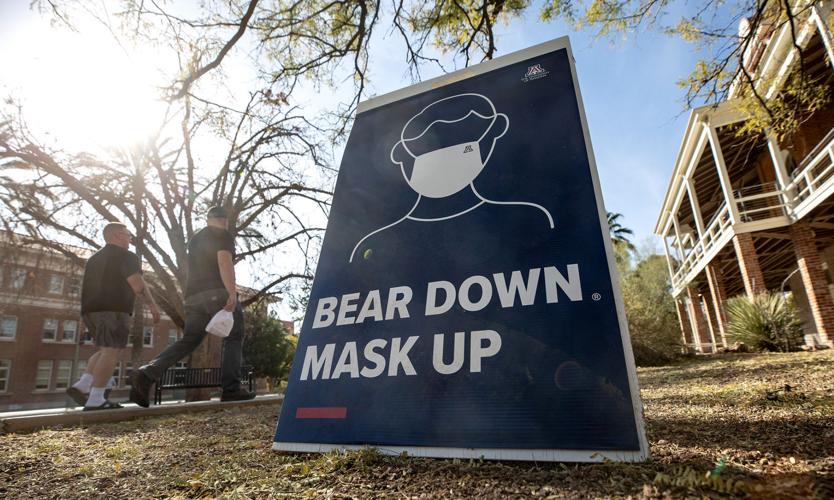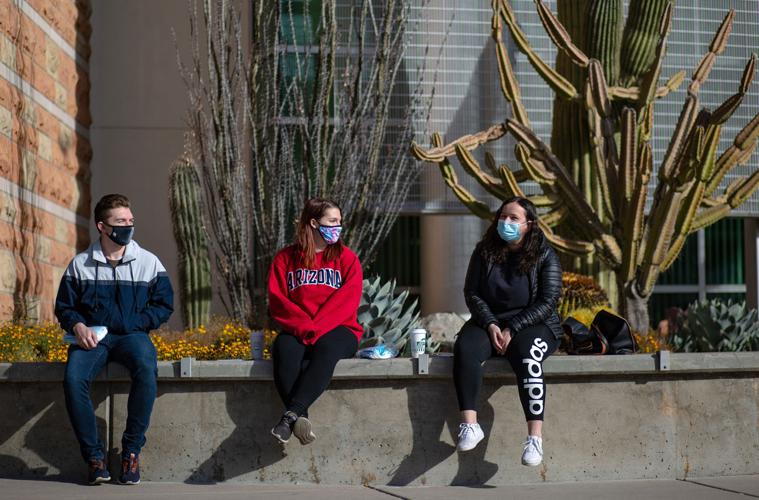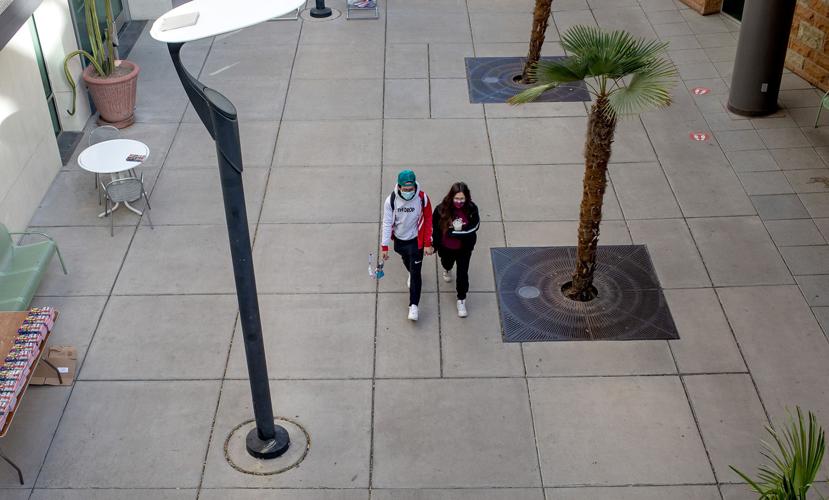University of Arizona students returned to school last week once again to a much quieter campus in the school’s second full semester impacted by the pandemic.
For some, like freshman Tiffany Edwards, a pandemic-disrupted campus atmosphere is the only experience she has had so far at the UA.
“I’m a freshman so I don’t know what normal here looks like. And I’m kind of looking forward to normal. … Sophomore year, that’s going to be a different story, I’m hoping,” Edwards said.
The Girls Scouts of Southern Arizona ended three days of cookie distribution with their Cookie Drop Friday, January 15, 2021, handing out 6,000 cases - 72,000 boxes - to 57 troops. All told GSSA hope their 2,400 scouts sell 700,000 boxes this year. Kelly Presnell / Arizona Daily Star
Students interviewed last week said they are working to get through the disruption this semester and cannot wait until things get back to normal.
The usual hustle and bustle of tens of thousands of students roaming around the UA Mall differed because more students stayed home to study online, according to school officials in early January.
The administration reported there would be about a bit more than 3,900 students enrolled in essential in-person courses, while the rest of the UA begins instruction online. Those students, along with faculty and staff make up approximately 8,000 to 10,000 on the UA campus at its peak times to start the semester.
“It’s really weird not having the rush of students between, let’s say 12:50 p.m. to 1 p.m., because everybody leaves class, everybody’s just rushing to their courses, and you’re trying to maneuver your way through it,” said Dana Pineda, a junior who transferred from Pima Community College. “Now it’s just so quiet and dead. There’s no one here.”
Since August, the campus has reported 3,626 positive COVID-19 tests out of 125,864 tests administered, according to the UA’s COVID-19 information website. From Jan. 7-16, the UA has seen 222 positive tests out of nearly 13,000 tests given.
The school is setting up to be a COVID-19 vaccination site to begin administering vaccines under Pima County Health Department distribution guidelines.
There are hopes to allow more in-person classes to open later in the semester, but the latest impacts of the coronavirus have been hitting Arizona the hardest, leading one official to label it the “hot spot of the world right now.”
That has led to more enhanced protocols deemed mandatory for those living on campus and those coming to campus for classes or other services.
On-campus students will test twice per week for COVID-19. Tests also need to be taken at least 48 hours apart. For those living off campus but attending instruction in-person also are required to take a weekly test.
The administration said it will be offering students a “variety of incentives to encourage compliance with regular testing.”
One would need to regain access to UA Wi-Fi, if testing protocols are not followed, the administration said.
The school is still using its wastewater testing to determine early if the campus living environments show signs of an outbreak. The process was first used last semester and likely saved two dorms from mass spread of the virus.
The Wildcat WellCheck, the school’s daily text-based coronavirus screening tool, has also been made mandatory by the administration. Students, faculty and staff answer a series of questions regarding the coronavirus and, if needed, it points them to proper resources.
“It’s not that difficult. It’s, what, 30 seconds a day?” said freshman Edwards, who is studying physiology. “They ask you ‘do you have any symptoms?’ You click ‘No.’ Are you going to be on campus today? You’re like, ‘yes.’ And then you move on with your life.”
Along with the changes for students is the thought of when the campus will return to more normal, Edwards added.
“I’m a visual learner, so this zoom meeting stuff gets a little difficult,” said Edwards, who began college life last semester never knowing what the campus normally looks like.
She said she has sought help from students in advanced math classes to help her in person instead of trying to get help through online platforms.
Edwards said she looks forward to trying out for volleyball and possibly sorority life once more control over the coronavirus is reached.
However, the campus still serves as an outlet for students like Pineda.
“I personally started coming to campus to study because I can’t focus at home. So, I would go to the library, and everything seems pretty safe,” Pineda said. “There’s hand sanitizer everywhere, there’s a lot of safe spacing, and there’s a lot of material for you to clean your work area. I’ve been pretty comfortable coming back and studying here.”
But the yearlong impact of the coronavirus on student life is not lost on seniors like Nicolas Alvarado, who is completing a degree in molecular and cellular biology.
“You have the sporting life, but it’s definitely been messed up,” Alvarado said. “It’s all right, but it would have been nice to been able to go to football games my senior year,” he said.
The administration hopes by late May to give Alvarado and the rest of the senior class a proper commencement send off.
President Robert Robbins voiced this optimism shortly before the spring semester got underway.
“I think we can have a successful spring semester and that particularly for our seniors who need these essential courses to graduate, that we can have a joyous and wonderful commencement celebration,” Robbins said.
Photos: Students return to Tucson for spring semester at the University of Arizona
UA Campus
Updated
Alex Brezovsky, a freshman at the University of Arizona, works on his laptop outside the Admissions Building near the University Mall, on Jan. 14, 2021.
UA Campus
Updated
A digital announcement sign reminds students, visitors and staff to social distance at the Student Union Memorial Center on the University of Arizona, on Jan. 14, 2021.
UA Campus
Updated
(From left to right) Nathan Rindlisbacher, Batya Salomonon and Andrea Shay who all work on the Covid Ambassador Team (CAT) sit outside the Student Union Memorial Center where they handout masks, on Jan. 14, 2021.
UA Campus
Updated
A couple walks through the Student Union Memorial Center on the University of Arizona, on Jan. 14, 2021.
UA Campus
Updated
People walk near the Tree Ring Building on the University of Arizona, on Jan. 14, 2021.
UA Campus
Updated
A sign reminding students, staff and visitors to wear a mask near Old Main on the University of Arizona, on Jan. 14, 2021.
UA campus
Updated
Tuition and fees will be increasing for some students at the University of Arizona for the 2021-22 school year. Incoming freshman from Arizona will not see a tuition increase in the fall.
UA Campus
Updated
A person walks through the Student Union Memorial Center on the University of Arizona, on Jan. 14, 2021.
UA Campus
Updated
Alex Brezovsky, a freshman at the University of Arizona, works on his laptop outside the Admissions Building near the University Mall, on Jan. 14, 2021.
UA Campus
Updated
People walk between the Centennial Building and Arizona Street Museum South on the University of Arizona, on Jan. 14, 2021.






